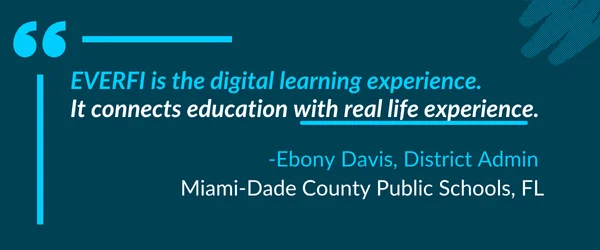- Blog
- Portrait of a Graduate: From Vision to Implementation in Your District
Portrait of a Graduate: From Vision to Implementation in Your District
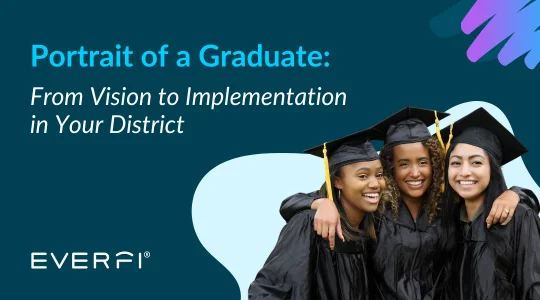
Across the country, districts and states are rethinking what it means to prepare students for the future. The Portrait of a Graduate is a powerful tool in that effort. It brings together educators, families, and community members to co-create a shared vision for student success.
It’s about more than academics; it’s about equipping students with the skills and character to lead meaningful lives.
- What is a Portrait of a Graduate?
- Reasons Your District Might Consider the Portrait of a Graduate Framework
- Key Components of an Effective Portrait of a Graduate Framework
- Help Your District with Creation and Implementation
- Measuring the Success of Portrait of a Graduate Frameworks
- How Everfi Supports the Portrait of a Graduate
What is a Portrait of a Graduate?
A Portrait of a Graduate (PoG) is a visionary framework that outlines the essential skills, competencies, and character traits students should develop by the time they graduate high school. It expands the definition of student success beyond traditional academic measures to include critical life and career skills like critical thinking, collaboration, communication, and citizenship. At its core, PoG supports an education that nurtures the whole child.
History and Adoption
The Portrait of a Graduate gained momentum after the passage of the Every Student Succeeds Act (ESSA) in 2015, which encouraged states to broaden their definitions of student achievement. Since then, nearly twenty states have adopted a statewide version of this holistic model, with many more districts creating their own.
Reasons Your District Might Consider the Portrait of a Graduate
Whether you’re just beginning to explore this concept or looking to deepen your district’s commitment to whole-child learning, here are five compelling reasons to consider adopting a Portrait of a Graduate:
- Establishes a Clear Vision for Student Success
PoG helps districts define what success looks like beyond test scores by identifying the skills students need to thrive in life, work, and civic life in the 21st century. - Aligns Stakeholders Around Shared Goals — Creating a PoG is a collaborative process that brings together educators, families, students, and community members. This shared vision fosters stronger alignment, engagement, and ownership across the district.
- Drives Instructional Innovation and Equity — By centering community values and diverse student needs, PoG encourages flexible, student-centered teaching strategies that promote equity and innovation in the classroom.
- Prepares Students for a Changing World — PoG addresses the “readiness gap,” which is the disconnect between traditional academic preparation and the real-world skills students need to thrive in a rapidly evolving economy and society.
- Serves as a Compass for Continuous Improvement — Once adopted, the PoG becomes a guiding force for curriculum development, assessment design, professional learning, and strategic planning, helping districts stay focused on what matters most.
Key Components of an Effective Portrait of a Graduate Framework
Ask five educators or employers to name the most important skills for success, and you’ll likely get five different answers.
While there may be common threads, each list reflects the unique values, priorities, and experiences of the person responding.
The same is true for every Portrait of a Graduate.
Foundational Competencies
What skills do believe are essential for success in both life and work?
Battelle for Kids, a leading developer and facilitator of PoG frameworks, highlights the 4C’s:
- Critical Thinking
- Communication
- Collaboration
- Creativity
These four competencies are widely recognized as vital for thriving in the 21st centery. They empower students to:
- Solve complex problems
- Work effectively with others
- Express ideas clearly
- Innovate with confidence
Backed by research and reflected in state and district frameworks across the country, the 4Cs form the foundation of most Portraits of a Graduate.
Optional Competencies
One of the greatest strengths of the Portrait of a Graduate is its adaptability. Each version is shaped by the unique values, workforce needs, and cultural context of the community it serves. This local customization is a key reason the framework has been embraced by so many districts and states.
For example, North Carolina’s Portrait of a Graduate includes empathy as one of its seven durable skills, reflecting the state’s emphasis on social-emotional learning and interpersonal development. South Carolina, on the other hand, emphasizes media and technology skills, aligning with its goals for workforce readiness and digital literacy.
A review of ten state-level POG frameworks reveals both commonalities and unique elements.
| Competency Adoption Across States | |||
| Competency | Universally Accepted | Regionally Accepted | Example States |
| Critical Thinking | ✅ | VA, OH, NC | |
| Communication | ✅ | NC, OH, SC | |
| Collaboration | ✅ | SC, TX, KY | |
| Creativity | ✅ | UT, IN, CO | |
| Citizenship | ✅ | VA, WA, SC | |
| Adaptability and Resilience | ✅ | KY, TX | |
| Digital Literacy | ✅ | UT, WA | |
| Empathy and Cultural Competence | ✅ | WA, CO | |
| Lifelong Learning | ✅ | IN, KY | |
| Career and Life Readiness | ✅ | SC, TX | |
While all ten states include the four C’s, five additional competencies appeared only in a few:
- Adaptability and Resilience
- Digital Literacy
- Empathy and Cultural Competence
- Lifelong Learning
- Career and Life Readiness
A fifth C, Citizenship, was included in all ten frameworks but is not yet as universally adopted as the original 4Cs. For this reason, we’ve placed it in the optional category.
How does this list compare to the skills you believe are most critical for success in life and work? What would your community prioritize in its own Portrait of a Graduate?
Help Your District with Creation and Implementation
Creating a Portrait of a Graduate is more than a design exercise. It’s a strategic, community-driven process that unites stakeholders around a shared vision for student success. While every district’s journey is unique, several key steps can help ensure the process is inclusive, meaningful, and actionable.
Build a Diverse Leadership Team
Start by forming a guiding coalition that reflects the full diversity of your district community. This team often includes:
- District leaders
- Principals
- Teachers
- Students
- Families
- Community leaders from business, higher education, and civic organizations
Their role is to lead the process, ask thoughtful questions, and ensure all voices are heard throughout the journey.
Engage the Community in Visioning
A strong Portrait of a Graduate is rooted in the hopes and expectations of the community that it serves. Host listening sessions, town halls, and surveys to gather input from a wide range of stakeholders. The goal is to uncover shared values and priorities that will shape the framework.
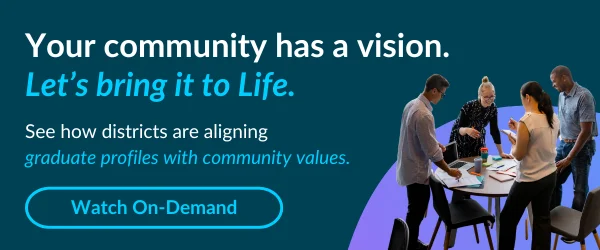
Identify Core Competencies
Using the insights gathered, the leadership team identifies a set of competencies that reflect the community’s vision for student success. These often include skills such as critical thinking, collaboration, adaptability, and empathy. The aim is to define a clear and concise set of attributes that every graduate should embody, regardless of their path after high school.
Design and Refine the Portrait
Once the competencies are established, the team creates a visual representation of the Portrait of a Graduate. This could take the form of a graphic, infographic, or poster that can be easily shared with students, staff, and families. It’s important to test the draft with stakeholders and refine it based on feedback to ensure it resonates across the community.
Align Systems and Practices
With the portrait in place, the next step is to align district systems to support it. This includes curriculum development, instructional practices, assessment strategies, and professional learning. The portrait should serve as a touchstone for decision-making and continuous improvement throughout the district.
!["Everfi was a big part of our [professional development]...We were able to get teachers comfortable with the content and with what they were doing." -Susan Bistrain, District Admin - Prince George’s County Public Schools, MD](/wp-content/uploads/2025/10/banner-quote-susan-bistrain.webp)
Celebrate and Sustain the Work
Launching your Portrait of a Graduate is a milestone worth celebrating. Districts often host events, create videos, and share stories that highlight how the portrait is coming to life in classrooms. Ongoing communication and reflection help keep the work visible and relevant, ensuring it becomes a living part of the district’s culture.
Measuring the Success of Portrait of a Graduate Frameworks
Creating a Portrait of a Graduate is a bold step toward redefining student success. But how do you know if it’s making a meaningful impact? The answer lies in measuring what matters most, including student growth, system alignment, and community connection.
Here are the key ways districts can assess the effectiveness of their Portrait of a Graduate:
Track Student Growth in Key Competencies
Your PoG likely includes competencies such as critical thinking, collaboration, and adaptability. While these skills may not be easily measured by traditional tests, they can be assessed through:
- Performance tasks and capstone projects that ask students to apply skills in real-world contexts
- Student portfolios that showcase growth over time
- Rubrics aligned to PoG competencies that provide clear expectations and feedback
These tools help educators and students recognize meaningful progress. They also support deeper learning and foster student agency. According to the Council of Chief State School Officers (CCSSO), using multiple measures of student learning is essential for capturing the full picture of readiness.
Align Systems to Support the Vision
A successful Portrait of a Graduate should influence more than just classroom posters. It should be embedded in curriculum, leadership decisions, and strategic planning. Districts can measure alignment by tracking:
- The number of instructional units or lessons tied to PoG competencies
- Professional development hours focused on related teaching strategies
- School improvement plans and leadership goals that reference the PoG
These indicators reveal whether the vision is shaping daily practice and long-term planning. The Learning Policy Institute emphasizes that system alignment is essential for sustaining innovation and advancing equity.
Listen to Your Community
Because the Portrait of a Graduate is grounded in community values, it’s important to check in regularly with those who helped shape it. Districts can gather feedback through:
- Surveys and focus groups with students, families, staff, and community members
- Listening sessions that explore how the PoG is showing up in classrooms and school culture
- Student reflections that bring the competencies to life through personal stories and experiences
When the community sees its values reflected in the work, the Portrait of a Graduate becomes more than a framework. It becomes a shared commitment to student success.
Use Data to Reflect and Refine
Measuring success is not about compliance. It’s about learning and growing together. Districts can use continuous improvement cycles to:
- Review data and learning artifacts
- Identify areas of strength and opportunity
- Adjust strategies and celebrate progress
This approach keeps the work dynamic and responsive. It also builds a culture of reflection, collaboration, and shared accountability.
By focusing on student outcomes, system alignment, and community engagement, districts can ensure their Portrait of a Graduate is not just a vision.
It becomes a catalyst for lasting change.
How Everfi Supports the Portrait of a Graduate
As more districts embrace the Portrait of a Graduate to redefine what student success truly means, Everfi stands out as a powerful partner in bringing that vision to life.
With a focus on real-world learning, equity, and student empowerment, Everfi’s no-cost digital resources align naturally with the competencies found in PoG frameworks.
Resources that Build Future-Ready Skills
Everfi offers a wide range of K–12 digital resources that help students develop the skills they need to thrive in college, career, and life. These engaging, standards-aligned lessons support many of the core competencies found in Portrait of a Graduate models, including:
- Critical thinking and problem-solving
- Communication and collaboration
- Empathy and emotional intelligence
- Civic responsibility and ethical decision-making
- Financial and digital literacy
Everfi’s resources are built to be relevant, accessible, and inclusive, helping districts bring their Portrait of a Graduate to life in classrooms every day.

Bring Everfi to Your District
Everfi’s platform of essential skills resources helps districts across the country prepare students for the real world, one lesson at a time.
More than 6.5 million students enrolled in at least one of Everfi’s standards-aligned resources last year.
Want to learn more? You have options:
- Explore Everfi’s resource catalog
- Teachers – Get registered and ready to use in under 5 minutes
- District leaders – Connect with your dedicated support team
Free for All School Districts
Thanks to partners, we provide our digital platform, training, and support at no cost.
See why 3 out of 5 districts partner with Everfi.
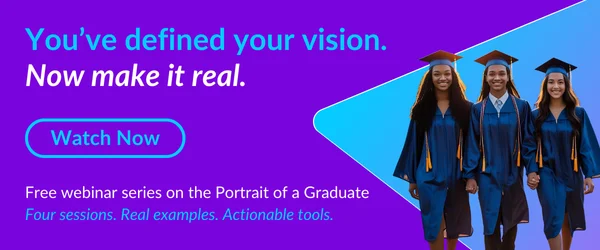
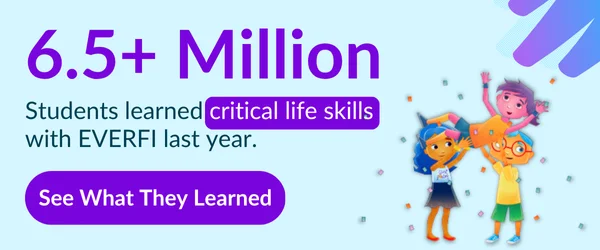
![To say I have been pleased with the Everfi team is an understatement. We are appreciative of the standards-based curriculum modules, the ease of [of use], and the aspect of them being self-graded. -Michele Pacheco, District Admin - Fresno Unified School District, CA](/wp-content/uploads/2025/10/banner-quote-michele-pacheco.webp)
